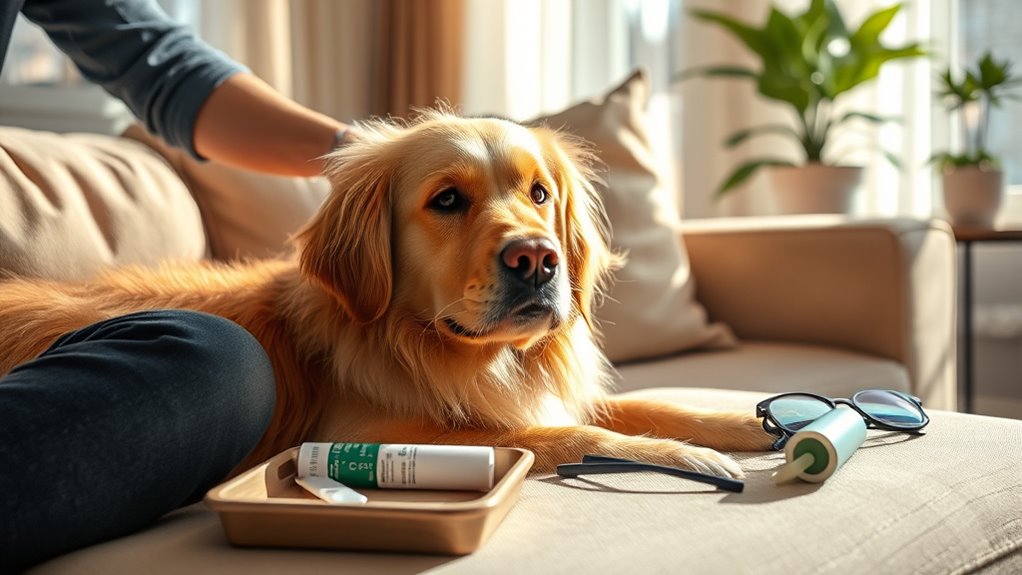Understanding pet allergies is key to managing your symptoms. Allergens in pet dander, saliva, and skin flakes can cause sneezing, itchy eyes, and asthma. To prevent reactions, regularly groom and bathe your pets, use HEPA filters, and keep pet-free zones like bedrooms. Cleaning surfaces and washing bedding also help reduce allergens. By following these steps, you can enjoy your pets while minimizing allergy symptoms—discover more effective strategies as you continue to learn about allergy management.
Key Takeaways
- Pet allergies are caused by dander, tiny skin flakes, that trigger symptoms like sneezing, itchy eyes, and asthma.
- Regular grooming, cleaning, and HEPA filtration help reduce airborne allergens and minimize allergic reactions.
- Creating allergen-free zones and using allergen-proof bedding lower exposure in sensitive areas like bedrooms.
- Choosing hypoallergenic pets or limiting interaction time can decrease allergy severity for sensitive individuals.
- Medical treatments such as allergy medications or immunotherapy can complement environmental measures for better allergy control.

Many people develop allergies to pets without realizing it, which can lead to uncomfortable symptoms and difficult choices. If you suspect pet allergies, understanding how to manage pet dander and implement allergen avoidance strategies becomes essential. Pet dander, tiny skin flakes shed by animals, contains allergens that can trigger reactions like sneezing, itchy eyes, or asthma attacks. The key to minimizing these symptoms starts with effective pet dander management, which involves reducing allergen levels in your environment. Regularly bathing and grooming your pet can considerably decrease the amount of dander they shed. Using a high-efficiency particulate air (HEPA) purifier helps trap airborne allergens, making the air safer to breathe. Frequent cleaning of your living space, including vacuuming with a HEPA-filter vacuum cleaner, also reduces pet dander buildup on surfaces and carpets. These steps don’t eliminate allergens entirely but can make a noticeable difference in your daily comfort. Implementing water-efficient flushing systems in your bathroom can also help conserve resources while maintaining hygiene, which is beneficial for overall household sustainability.
Allergen avoidance strategies play an equally essential role in managing pet allergies. Creating allergen-free zones within your home, such as the bedroom, allows you a space to breathe more freely without exposure to pet dander. Keep pets out of these designated areas, and consider using allergen-proof bedding covers to prevent dander accumulation on mattresses and pillows. Washing your pet’s bedding, toys, and any fabric items they frequently contact helps reduce the overall allergen load. When interacting with your pet, washing your hands immediately afterward and avoiding touching your face can prevent transferring allergens to sensitive areas like your eyes or nose. If you’re highly allergic, you might also consider limiting the time spent with your pet or choosing pets with less dander, such as certain dog breeds or hypoallergenic cats.
In some cases, allergy medications or immunotherapy may be recommended by healthcare professionals for more severe reactions. However, the foundation of effective pet allergy management lies in proactive pet dander management and consistent allergen avoidance strategies. By maintaining a clean environment, controlling pet exposure, and adopting specific habits, you can considerably reduce your allergic reactions and enjoy a more comfortable living space. Remember, the goal isn’t necessarily to eliminate your pet but to create a balanced environment where you can coexist more peacefully. Taking these steps not only improves your quality of life but also helps you maintain a healthier, allergen-controlled home.
Frequently Asked Questions
Can Pet Allergies Develop Later in Life?
Late onset allergies can develop at any age, so you might notice new adult pet sensitivity even if you’ve never had allergies before. Factors like changes in your immune system or increased exposure to pet dander can trigger these allergies later in life. Don’t assume you’re immune just because you didn’t react in the past. Stay aware of symptoms and consult a doctor if you suspect adult pet allergy development.
Are Certain Breeds Less Likely to Cause Allergies?
Oh, sure, picking a hypoallergenic pet guarantees a sneeze-free life, right? Sadly, breed-specific allergies are more myth than magic. No breed is truly allergy-proof, but some like Poodles or Bichon Frises are often called hypoallergenic pets because they shed less. Still, if you’re allergic, it’s best to spend time with a breed first; no guarantee, just a better shot at avoiding those itchy surprises.
How Do Pet Allergies Differ From Pet Sensitivities?
Pet allergies cause your immune system to react strongly to pet dander, leading to symptoms like sneezing, itchy eyes, and congestion. Sensitivities, however, are milder and may not trigger immune responses or typical pet allergy symptoms. To distinguish them, allergy testing methods like skin or blood tests are useful. If you’re unsure, consulting a doctor can help identify whether you have allergies or sensitivities, guiding proper management and prevention strategies.
Can Allergy Medications Be Safely Used Long-Term?
Think of allergy medications as your loyal sidekick; they can be safe for long-term use when properly managed. You should consult your vet to guarantee your allergy management plan includes appropriate long-term medication, as some might have side effects if used excessively. With regular check-ups, you can keep allergy symptoms at bay while maintaining your pet’s health, just like a hero staying vigilant in their quest.
Do Pet Allergies Improve With Age or Exposure?
Pet allergy symptoms can sometimes improve with age or exposure, but it varies by person. Many pet allergy myths suggest that exposure builds tolerance, but allergy testing is the best way to confirm sensitivities. Some individuals notice reduced reactions over time, while others may experience persistent symptoms. If you’re concerned, consult an allergist to discuss allergy testing and develop a tailored management plan, rather than relying solely on exposure.
Conclusion
Now that you know the ins and outs of pet allergies, you hold the keys to a happier, healthier home. Think of it as tending a delicate garden—regular care and attention keep the weeds of allergy at bay. With a little effort, you can create a cozy haven where both you and your furry friend thrive, like two stars shining brighter together in the night sky. Your journey to allergy-free living starts today!









